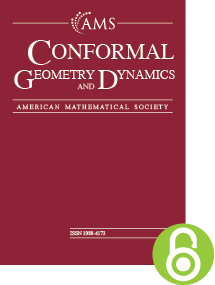Constructing subdivision rules from alternating links
HTML articles powered by AMS MathViewer
- by Brian Rushton
- Conform. Geom. Dyn. 14 (2010), 1-13
- DOI: https://doi.org/10.1090/S1088-4173-09-00205-7
- Published electronically: January 5, 2010
- PDF | Request permission
Abstract:
The study of geometric group theory has suggested several theorems related to subdivision tilings that have a natural hyperbolic structure. However, few examples exist. We construct subdivision tilings for the complement of every nonsingular, prime alternating link. These tilings define a combinatorial space at infinity, similar to the space at infinity for word hyperbolic groups.References
- Colin C. Adams, The knot book, American Mathematical Society, Providence, RI, 2004. An elementary introduction to the mathematical theory of knots; Revised reprint of the 1994 original. MR 2079925
- I. R. Aitchison, E. Lumsden, and J. H. Rubinstein, Cusp structures of alternating links, Invent. Math. 109 (1992), no. 3, 473–494. MR 1176199, DOI 10.1007/BF01232034
- J. W. Cannon, W. J. Floyd, and W. R. Parry, Finite subdivision rules, Conform. Geom. Dyn. 5 (2001), 153–196. MR 1875951, DOI 10.1090/S1088-4173-01-00055-8
- J. W. Cannon and E. L. Swenson, Recognizing constant curvature discrete groups in dimension $3$, Trans. Amer. Math. Soc. 350 (1998), no. 2, 809–849. MR 1458317, DOI 10.1090/S0002-9947-98-02107-2
- W. J. Floyd. tilepack.c, tilepackhistory.c, subdivide.c and subdividehistory.c. Software, available from http://www.math.vt.edu/people/floyd/.
- William W. Menasco, Polyhedra representation of link complements, Low-dimensional topology (San Francisco, Calif., 1981) Contemp. Math., vol. 20, Amer. Math. Soc., Providence, RI, 1983, pp. 305–325. MR 718149, DOI 10.1090/conm/020/718149
- W. Menasco, Closed incompressible surfaces in alternating knot and link complements, Topology 23 (1984), no. 1, 37–44. MR 721450, DOI 10.1016/0040-9383(84)90023-5
- B. Rushton. Alternating links and subdivision rules. Master’s thesis, Brigham Young University, 2009.
- K. Stephenson. Circlepack. Software, available from http://www.math.utk.edu/$\sim$kens.
Bibliographic Information
- Brian Rushton
- Affiliation: Department of Mathematics, Brigham Young University, Provo, Utah 84602
- Email: brirush@gmail.com
- Received by editor(s): August 6, 2009
- Published electronically: January 5, 2010
- © Copyright 2009
American Mathematical Society
The copyright for this article reverts to public domain 28 years after publication. - Journal: Conform. Geom. Dyn. 14 (2010), 1-13
- MSC (2010): Primary 57M50
- DOI: https://doi.org/10.1090/S1088-4173-09-00205-7
- MathSciNet review: 2579862


